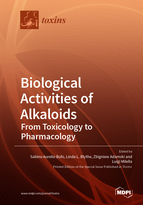Biological Activities of Alkaloids: From Toxicology to Pharmacology
A special issue of Toxins (ISSN 2072-6651). This special issue belongs to the section "Plant Toxins".
Deadline for manuscript submissions: closed (31 December 2019) | Viewed by 82249
Special Issue Editors
Interests: pharmaceuticals from plants and microorganisms; chemistry of natural substances in vegetables and soil; secondary plant metabolites; protection and recovery of ecosystems
Special Issues, Collections and Topics in MDPI journals
Interests: Veterinary Pharmacology, Toxicology and Pharmaceutics Environmental Science, Agricultural and Biological Sciences, Immunology and Microbiology
Interests: lethal and sub-lethal effects of plant-derived substances and their possible application as insecticides and nematicides; effects of alkaloids at cell and tissue level; alkaloid-procured lethality, altered fecundity, fertility, and morphological malformations of tested organisms
Special Issues, Collections and Topics in MDPI journals
Interests: secondary metabolite isolation; structural determination; oxidative stress; nutraceuticals; bioactive molecules; cholinesterase inhibitory activity; Alzheimer’s disease; cytotoxic effects
Special Issues, Collections and Topics in MDPI journals
Special Issue Information
Dear Colleagues,
Plants produce many substances, the so-called secondary metabolites, which have biological activity. They are distinct from the components of the primary metabolism as they are generally not essential for the basic metabolic processes of the plant. However, they often have the character of physiologically active compounds that makes them applicable in different fields, for instance medicine or agriculture.
A broad spectrum of physiological activity is demonstrated by alkaloids. Their rich diversity results in part from an evolutionary process driven by selection for the acquisition of an improved defense against microbial attacks or the predation of herbivores. A positive aspect is that their main role in plants is to protect them from diseases caused by pests. However, some alkaloids are of concern to veterinary toxicology because of their occurrence in plant species involved in animal poisoning, which usually occurs when plants contaminate hay or silage or when forage alternatives are not available. At times, some toxicity effects have also been highlighted in human nutrition. Other components of this class of compounds have been proved to exhibit antioxidant, anti-inflammatory, anti-aggregation, hypo-cholesteric, immunostimulant or anticancer properties. In fact, the effects of toxicity can be both harmful and beneficial depending on the ecological or pharmacological context, and, as often pointed out, are dose-dependent.
The interest of researchers in the study of the bioactivity of plant alkaloids is still very keen. In this Special Issue, ecological, biological, pharmacological and toxicological effects as well as structural and analytical aspects of plant alkaloids will be collected. Reviews and original research contributions are expected on, but not limited to, the biological activity of natural alkaloids against pathogens, herbivores and cancerous cells, or unwanted physiological conditions, including metabolism and accumulation. Studies on alkaloid biosynthesis and action mechanisms are welcome to improve the selection and production of biologically active molecules, to discover new substances, and to exploit them in a sustainable way against targets of concern.
Prof. Dr. Sabino Aurelio Bufo
Prof. Dr. Linda L. Blythe
Prof. Dr. Zbigniew Adamski
Dr. Luigi Milella
Guest Editors
Manuscript Submission Information
Manuscripts should be submitted online at www.mdpi.com by registering and logging in to this website. Once you are registered, click here to go to the submission form. Manuscripts can be submitted until the deadline. All submissions that pass pre-check are peer-reviewed. Accepted papers will be published continuously in the journal (as soon as accepted) and will be listed together on the special issue website. Research articles, review articles as well as short communications are invited. For planned papers, a title and short abstract (about 100 words) can be sent to the Editorial Office for announcement on this website.
Submitted manuscripts should not have been published previously, nor be under consideration for publication elsewhere (except conference proceedings papers). All manuscripts are thoroughly refereed through a double-blind peer-review process. A guide for authors and other relevant information for submission of manuscripts is available on the Instructions for Authors page. Toxins is an international peer-reviewed open access monthly journal published by MDPI.
Please visit the Instructions for Authors page before submitting a manuscript. The Article Processing Charge (APC) for publication in this open access journal is 2700 CHF (Swiss Francs). Submitted papers should be well formatted and use good English. Authors may use MDPI's English editing service prior to publication or during author revisions.
Keywords
- plant secondary metabolites
- alkaloids
- biological activity
- toxicity
- biopesticides
- natural pharmaceuticals









